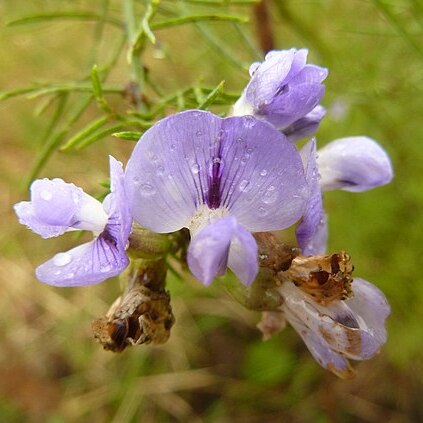Woody herb or subshrub 0.6-1.5 m tall; branches striate, glabrous or with a few short hairs on youngest parts. Leaves 5-9-foliolate; leaflets 10-25 x 0.7-1.1 mm, linear, apiculate, glabrous, gland-dotted; stipules 1-2 x c. 0.5 mm, lanceolate, acute. Peduncles 1-2 cm long, 1-flowered, fasciculate, 1-4 together, axillary in upper leaves and terminal, glabrous or sparsely pubescent; 2 bracts at apex united to form a cup around the peduncle, 2.5 mm long, triangular; pedicels 2-3 mm long. Calyx tube 3-4.5 mm long, ribbed and gland-dotted; lobes (1)2-4.5 x 1.2-2 mm, ovate-triangular, subequal; tube and lobes sometimes densely dark pubescent within and appearing ciliate. Standard blue, 10-12 x 9-11 mm, obovate with claw 2 mm long; wings 9 x 3 mm, narrowly oblong-oblanceolate; keel dark blue-purple at apex, 5 x 2.8 mm, claw 5 mm long. Vexillary filament free. Ovary 1.3 mm long; style straight for 6 mm then curved upwards for 2.5 mm. Fruit 5 x 2.5 mm, ± oblong, wrinkled. Seed dark brown, 4.2 x 2.2 mm, oblong-reniform; hilum 1.2 mm long.
Woody shrub, up to 1.5 m high, resprouter. Stems greyish brown, with white lenticels and vertical fissuring. Stipules subulate, recurved, twisted, acute, glabrous, equalling or ± 1/2 length of petioles. Leaves 5-9-foliolate. Leaflets linear, apiculate, tip down curving, glabrous, basal pair longest, keel-shaped. Inflorescences axillary, 1-3-flowered, clustered along seasonal shoots. Cupulum 2-fid with lower cleft. Flowers blue and white. Calyx: teeth equal, glabrous to sparsely haired. Petals: standard obovate, dark blue to dark mauve with large M-shaped nectar guide and purple patch in cleft, veins purple; wings white, longer than keel. Flowering time Aug.-Apr.
Peduncles 1–2 cm long, 1-flowered, fasciculate, 1–4 together, axillary in upper leaves and terminal, glabrous or sparsely pubescent; 2 bracts at apex united to form a cup around the peduncle, 2.5 mm long, triangular; pedicels 2–3 mm long.
Calyx tube 3–4.5 mm long, ribbed and gland-dotted; lobes (1)2–4.5 × 1.2–2 mm, ovate-triangular, subequal; tube and lobes sometimes densely dark pubescent within and appearing ciliate.
Standard blue, 10–12 × 9–11 mm, obovate with claw 2 mm long; wings 9 × 3 mm, narrowly oblong-oblanceolate; keel dark blue-purple at apex, 5 × 2.8 mm, claw 5 mm long.
Leaves 5–9-foliolate; leaflets 10–25 × 0.7–1.1 mm, linear, apiculate, glabrous, gland-dotted; stipules 1–2 × c. 0.5 mm, lanceolate, acute.
Woody herb or subshrub 0.6–1.5 m tall; branches striate, glabrous or with a few short hairs on youngest parts.
Ovary 1.3 mm long; style straight for 6 mm then curved upwards for 2.5 mm.
Seed dark brown, 4.2 × 2.2 mm, oblong-reniform; hilum 1.2 mm long.
Fruit 5 × 2.5 mm, ± oblong, wrinkled.
Vexillary filament free.

